This was published 8 years ago
Cocos Islands holidays: This remote Australian outpost is a desert island fantasy
The Cocos Islands sit thousands of kilometres north-west Perth, yet they have played a crucial role in communication in the Indian Ocean for years.
By Ben Stubbs
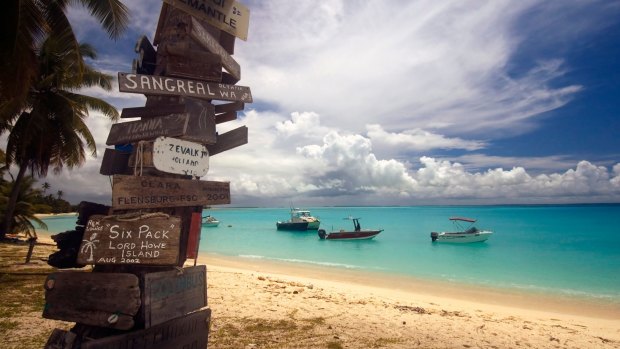
Ships sheltered in the safe anchorage at Direction Island, Cocos Keeling Credit: Alamy
I walk along the beach in a zigzagging pattern. My head is down and I'm frowning as one bar becomes two and suddenly two become none.
If you ask travellers what is at the top of their priority list, the ability to communicate with the outside world would be up there. While the ease of communication is something we undoubtedly take for granted in the generation of Skype, Whatsapp and instant messaging, on the remote Cocos Islands the ability to connect with the outside world has defined this place for more than 100 years.
I am on Direction Island, one of the 27 Cocos (Keeling) Islands, looking for Wi-Fi to message my family. This place is 2750km north-west of Perth, hundreds of kilometres from anywhere else, yet I can still pick up a signal if I head towards the beach from the path near the environmental loo. It takes me a moment to realise that I'm ignoring the view of palm trees and a coral lagoon in front of me because I'm obsessed with following the bars of my phone.
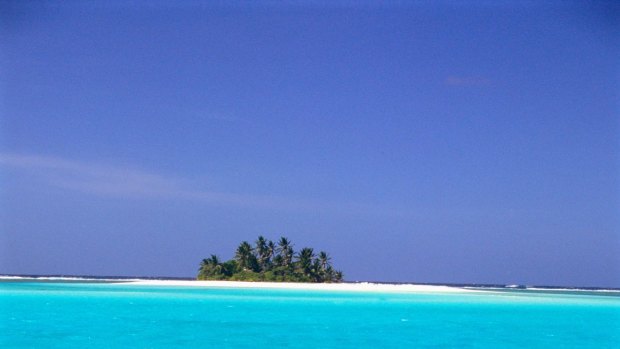
The Cocos Islands offers beautiful snorkelling opportunities. Credit: Alamy
The Cocos Islands were discovered by Captain William Keeling of the East India Company in 1609 and weren't properly settled until Scottish trader John Clunies-Ross and merchant Alexander Hare both had designs on the place in the early 19th century. Clunies-Ross brought in Malay, Chinese, Papuan and Indian workers to harvest copra, and Hare was accompanied by a harem of women to complete his desert island fantasy.
Hare's harem didn't work out, so he left and Clunies-Ross assumed control as the self-appointed 'king' of the islands. The islands operated as the family's kingdom until it was passed over to Australian control in 1955 and the people voted for proper integration in 1984.
While it is quite easy for me to appreciate the isolation of the Cocos Islands alone on an idyllic beach, as international communication became more important in the early 20th century, the Cocos Islands became a vital link for the rest of the world. The deep-sea cables were laid from the Cocos Islands and a cable station was built here in 1901. One cable stretched all the way from the Cocos to Rodriguez Island off Mauritius, thus connecting it with Africa, another to Java and onwards to Europe and the third to Cottesloe in Western Australia.
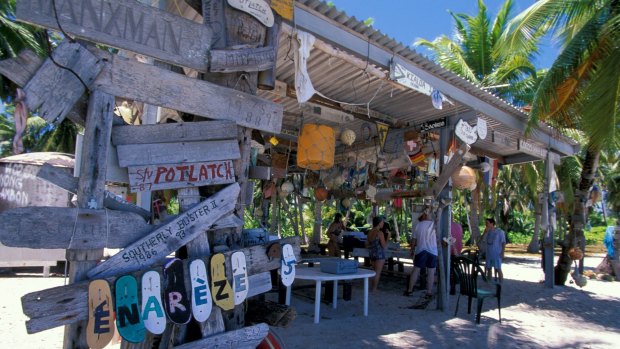
A shelter on Direction Island, one of the main Cocos Islands.Credit: Alamy
Rudyard Kipling wrote of the strange, far-reaching cables: "They have wakened the timeless things; they have killed their father time; joining hands in the gloom, a league from the last of the sun."
Eventually this connectedness extended to the building of a wireless station out on Direction Island in 1911, which allowed ships within a radius of 460km to communicate with the island. The connections of the Cocos Islands came into focus in November 1914 as the German cruiser SMS Emden appeared in the cove, intent on destroying the Cocos Islands' communications facilities and severely damaging the Allied war effort.
The HMAS Sydney intervened and disabled the Emden off North Keeling Island. Australia lost four sailors and Germany 134; it was Australia's first major victory of the Great War.
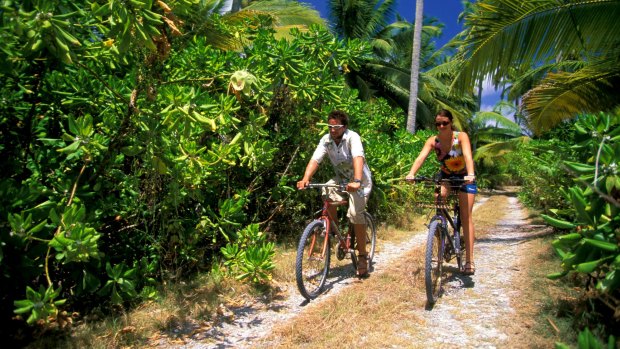
Cycling West Island in the Cocos.Credit: Alamy
From 1900 until the 1950s, the wireless station provided an important connection with the outside world, though for the men charged with manning the station, life was one of isolation and monotony. When passing ocean liners and cruise ships would come near to the Cocos, the men devised a daring method for communicating with those on board. The Cocos Barrel was built to communicate with those passing ships and to get a supply of luxuries which were in short supply, such as fresh meat, magazines and even letters from back home. The men would sail a traditional jukong boat out as the liner came past and a barrel with supplies was tossed overboard. The Cocos men would then attach a sealed tin can to a rope hanging from the liner for return letters and payment.
Most of the expat community of the Cocos Islands now lives on West Island, a 15km sliver of flat land ringed with palm trees, turquoise water and carpets of hibiscus flowers. As I discover early on, the point when visiting the islands is to disconnect from the outside world in order to experience this place that is at once completely foreign and also just like every Australian beach town you've been to. There are cafes, surf shops and island tours, though I'm after something a little more idiosyncratic.
The Cocos Islands boast the world's only golf course across an international runway. I hire a set of clubs, an Esky to keep the beer cold and I sign up for the Thursday afternoon "scroungers" Ambrose golf event, where a group of locals meander across the course as the sun sets. It doesn't take long before I learn nicknames such as "Wazza", "Digger" and "Jules" and once I shank my first shot into the lagoon, I hear the call "I hope you brought your snorkel!" – and I feel a little closer to what makes this place tick. Scores are irrelevant and it's more about chatting and unwinding with a group of friends. Keys are left in cars here, "I.O.U." systems are still functioning and barbecues and weekends seem to be for the whole community to share.
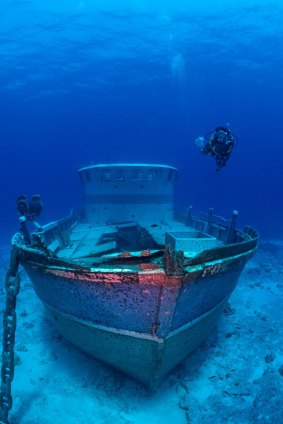
A diver checks out a wreck off the coast of the Cocos Islands.Credit: Alamy
I "research" the connections of the Cocos Islanders well into the night as scroungers moves to a local restaurant and then across to the pub for community snooker.
The next morning, a little head sore and bleary, I travel out into the lagoon from West Island with Kylie and Ash James in their motorised canoes. I want to get a better idea of the other islands. We purr across the aqua water; they say it's rough today, though I bet I could drink a cup of tea without spilling it in the saucer as we cross.
Even though the communities of the Cocos Islands live on only two islands – the rest are deserted Robinson Crusoe atolls – we pass vacant beaches with pondoks set up by the Cocos Malay people. There are shelters, hammocks, machetes and caches of coconuts to split and share and supplies left for the next visitor. We float across the water in between snorkelling and exploring the World War II history. Turtles the size of dinner tables flap around beneath us and reef sharks dart into the shadows.
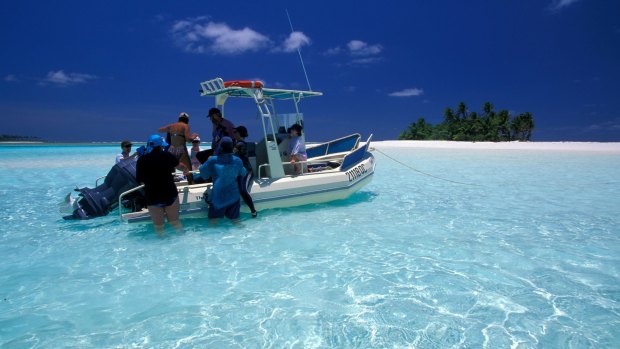
Arriving at Prison Island.Credit: Alamy
Across the lagoon I see the buildings of Home Island. While most of the expat Australians live on West Island, and it is an image of tropical Australia with barbecues and sport bringing people together, life on Home Island is quite different. I spend my last night on this peaceful island where the 400 Cocos Malay residents have made their home. Malay is the first language here, there are two mosques and the open layout of the houses and little laneways helps connect this community, which has been here since Clunies-Ross and Hare brought their ancestors across to the island.
I am met by one of the elders of the island. He is a devout Muslim who went to Mecca in 2011. Nek Su, with his bowler hat and big grin is the de facto leader of this place; he is revered and respected because of all the things he has done for Home Island over his lifetime. Fisherman, welder, builder, imam, boat builder and husband are just a few of the titles associated with Nek Su. He tells me stories of meeting the Queen in 1955 and catching 4-metre tiger sharks in the lagoon as we tour the island in his motorised golf cart.
I see the white sands of Turtle Beach, the cemetery where the Clunies-Ross family and Nek Su's parents are buried and we are treated to a traditional fish and curry dinner, cooked by his sister. It is quiet and the breeze licks up as the sun dissolves across the water. The call to prayer drifts across the island and Nek Su walks with me to the mosque. The men are dressed in neat and clean tunics. I watch from outside as they pray and I'm introduced to the rest of his family once prayers finish.
Home Islanders and West Islanders are quite different – just as Cocos people and mainlanders can be, though as I return to West Island and my phone flashes with an internet signal, it reminds me that despite geographical disparity, wealth, culture and history, there is a connection between all of us – even in places as remote and removed as the Cocos Islands. Sometimes we need to go to the edges to remember that a connection often means more than just the search for a Wi-Fi signal.
TRIP NOTES
MORE INFORMATION
www.cocoskeelingislands.com.au
GETTING THERE
Virgin Australia have regular flights to the Cocos Islands (via Christmas Island) from Perth; see www.virginaustralia.com.au
STAYING THERE
There are a variety of self-contained and more luxurious accommodation options on West Island to suit families and couples and motel accommodation for the more budget-conscious; the Bird's Nest and The Castle are recommended. There are also limited options on Home Island, including Oceania House (which was once the Clunies-Ross' family home) and a self-contained unit in Nek Su's home.
The writer was assisted by Cocos (Keeling) Islands Tourism.
See also: The six best Australian islands you've never heard of
See also: Australia's second-largest island still almost unknown to tourists
Sign up for the Traveller Deals newsletter
Get exclusive travel deals delivered straight to your inbox. Sign up now.